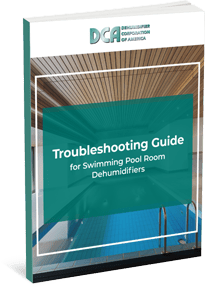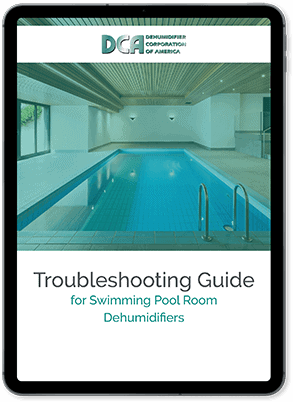Monitoring and managing indoor humidity levels can be challenging in any type of space, but indoor pool rooms present unique difficulties. Without careful attention and management, imbalanced room air temperature and pool water temperature relationships in these rooms can cause corrosion, condensation, mold, mildew and poor air quality affecting swimmers comfort and building integrity.
In commercial indoor pool rooms, trained employees are typically on hand to manage dehumidification processes, temperature monitoring, and pool water chemistry. However, residential pool rooms usually can’t rely on employees for upkeep, nor can most semi-commercial spaces in hotels and condos; service technicians are available, but their visits are usually infrequent.
Partnering with knowledgeable HVAC professionals — ones that can provide useful feedback, recommend reliable technology, and suggest customized management plans for monitoring and controlling humidity levels — can allow for significant time and cost savings.
Pool Room Dehumidification Basics
To properly manage an ideal indoor pool space, structured dehumidification standards are essential to follow. One of the most important standards is to maintain pool room air temperature 2 to 4 degrees warmer than that of the pool water temperature. This relationship allows minimal pool water evaporation into the air of the pool room. Having the pool room air temperature cooler than the water temperature encourages pool water evaporation into the air causing dehumidification systems to run longer than needed.
It may seem practical to alter a system’s dehumidifier set points during daily pool use, but this can be highly disruptive and not recommended. Normally pool water temperature set points are constant and by extension the room air temperature will be constant as well. Below are three common situations illustrating this.
- In an attempt to save on energy and operating costs, some pool managers will cover a pool and then lower the room temperature during the time the pool is closed. This practice is not recommended but can be done if needed. Before the pool cover is retracted the room air temperature must be brought up to 2 – 4 degrees warmer than the pool water temperature or an instant fog will be released, covering the windows of the room with condensation.
- When large groups of people gather in the pool room for a party or an event, the room temperature rises naturally and the guests may find the room air temperature uncomfortable. If the dehumidifier set point is dropped to accommodate the guests, the dehumidification system may not be able to keep up with the rising room air temperature and moisture output from the imbalance.
- Pool managers looking for a way to accommodate a diverse swimming audience may want to quickly heat up or cool down the pool water by adjusting the temperature of the thermostat or the water heating source. However, this can quickly double the room’s moisture load, making it impossible for even an oversized dehumidifier to keep up.
Pool Room Dehumidifier Management Solutions from DCA
While adjusting a pool room’s dehumidifier’s controls set points may seem like a quick, practical way to save money, it can ultimately ruin a pool room. At DCA, our expert engineers create custom pool room dehumidification systems to perfectly suit clients’ unique applications. We provide fully automatic dehumidification systems, allowing for stress-free, reliable humidity management control.
One of DCA’s newer control systems, Honeywell Prestige, allows for remote viewing & adjustment of pool room temperature along with the relative humidity set point. This versatile solution also features a color touchscreen for optimal ease of use. Our team provides all initial setup services.
To learn more about the Honeywell Prestige or discuss how our dehumidification systems can help with your specific pool room application, reach out to the team today.





